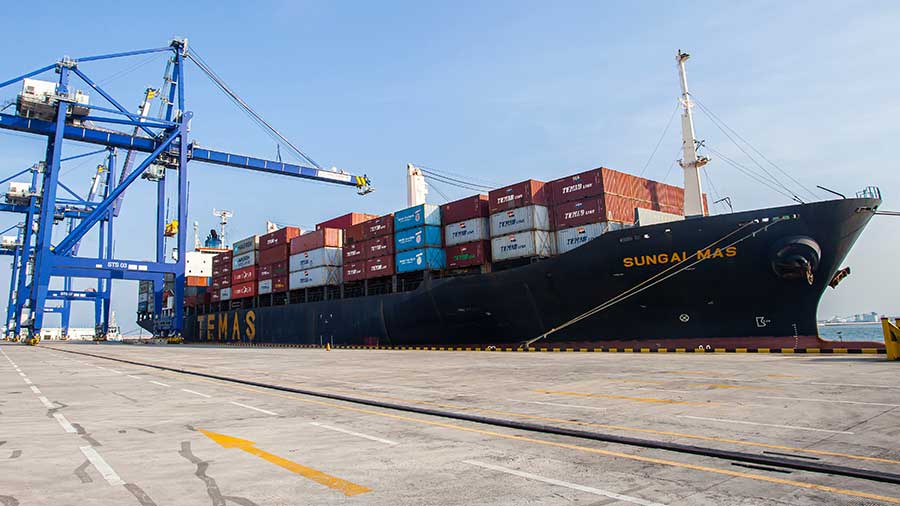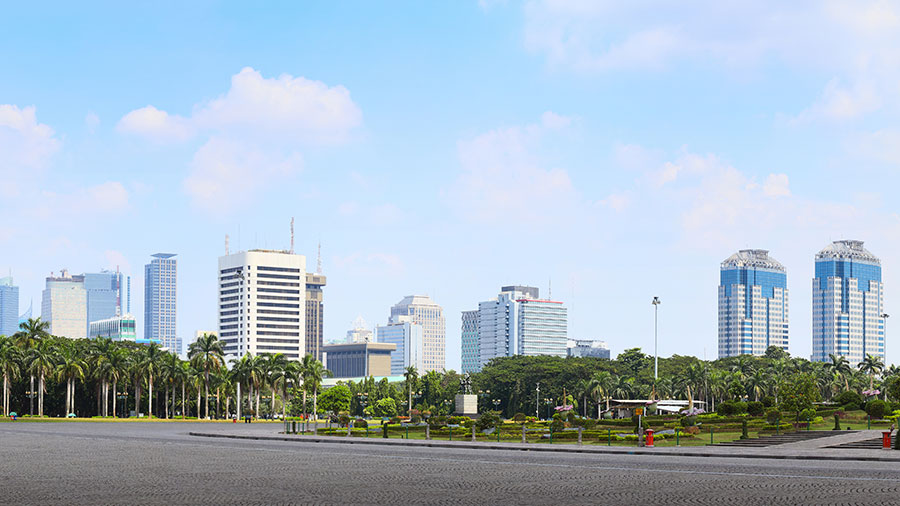Economic Indicators and Indonesia's GDP, FDI, and Trade Trends
Gross Domestic Product growth and forecast
Indonesia’s central bank, Bank Indonesia, predicts that the country’s economy is expected to grow at between 4.5-5.3 percent in 2023 – one of the highest among G20 members – and will be supported by several important sectors, including commodities, infrastructure development, tourism, and manufacturing of high-value products, such as electric vehicle batteries.
GDP had accelerated to 5.31 percent in 2022, bringing Southeast Asia’s largest economy back to pre-pandemic growth. The pace of growth in 2022 was largely supported by Indonesia’s large domestic consumption and further bolstered by the export of commodities as global prices of key shipments, such as coal, palm oil, and iron, rallied upwards.
Indonesia saw a breakthrough year in 2022 and recorded some US$43 billion in FDI, the highest in the country’s history.
The highest priority for the Indonesian government for 2023 will be to hold inflation at three percent. Further, weakening global economic activity and a slowdown in commodity prices could impact GDP this year. However, external demand for commodities and pent-up domestic consumption will continue to be the backbone of growth in 2023.
Foreign Direct Investment trends
Foreign direct investment into Indonesia (excluding investment in banking and the oil and gas sectors) increased 20.2 percent year-on-year to a new record peak of IDR 177 trillion (US$ 11.96 billion) in the first quarter of 2023, amid efforts by the government to ease business and licensing rules.
Singapore (US$ 4.3 billion) was the biggest source of investment, followed by Hong Kong (US$ 1.5 billion), China (US$ 1.2 billion), and Japan (US$ 1 billion) while base metals were the biggest recipient amid efforts to boost investment in processed minerals.
In total, Indonesia recorded IDR 328.9 trillion (US$ 22.4 billion) of foreign and domestic investment during the first quarter, up 16.5 percent from a year earlier, boosted by a rise in investment in base metals, transportation, and the mining sector. For 2023, the government has set a target to draw IDR 1,400 trillion (US$ 95.5 billion) of investment from domestic and foreign sources.
According to the Indonesian Investment Coordinating Board, or the BKPM, Indonesia received US$43 billion in foreign investment in 2022, the highest in the country’s history and an increase of 44 percent from 2021. When combined with domestic investments, Indonesia saw 1,207 trillion rupiah (US$80 billion) in investments, an increase of 34 percent from the previous year.
Foreign investment in Indonesia in 2022 was dominated by the metal mining and mining sectors, which saw more than US$16 billion in FDI combined.
For 2023, the government is expecting 1,400 trillion rupiah (US$92 billion) in combined foreign and domestic investments, and 1,650 trillion rupiah (US$108 billion) in 2024.
Indonesia’s import and export statistics
Indonesia is rich in natural resources - including crude oil, natural gas, tin, copper, and gold. This also constitutes the bulk of Indonesian exports. Machinery and equipment, chemicals, fuels, and foodstuffs are among the most valuable imported goods.
Data from Statistics Indonesia (BPS) recorded 2022 exports worth US$291.98 billion, an increase of 26.07 per cent year-on-year. Imports in 2022 were valued at US$237.52 billion, an increase of 21.07 per cent year-on-.A commodities-led export boom has helped Indonesia’s post-pandemic recovery. However, economic momentum is expected to slow down as commodity prices ease and global monetary policy changes hits demand.
Total exports reached US$ 23.8 billion in December 2022. Further, exports decreased in April of 2023 to US$ 19.29 billion, a 15-month low, from US$ 23416.90 million in March 2023.
Indonesia’s major export partners in 2022:
- China 23.31%
- ASEAN 19.07%
- United States 11.75%
- European Union 8.16%
- Japan 7.70%
- India 5.96%
- South Korea 3.63%
- Hong Kong 3.01%
In the long-term, the Indonesia Exports is projected to trend at a monthly average of US$16 billion in 2023 and (US$17.7 billion in 2024.
Indonesia’s import statistics
In January 2023, imports to Indonesia increased by 1.27 percent year on year to US$ 18.44 billion. However, imports to Indonesia started to decline in the following months, missing the market forecasts.
Imports to Indonesia fell by:
- 32 percent YoY to USD 15.92 billion in February 2023;
- 26 percent YoY to USD 20.59 billion in March 2023; and
- 32 percent YoY to USD 15.35 billion in April 2023.
Indonesia’s major import partners in 2022:
- China 32.66%
- ASEAN 17.17%
- Japan 8.56%
- European Union 6.43%
- South Korea 5.23%
- United States 5.09%
- Australia 4.96%
- India 3.97%
| Indonesia Economic Profile (1990-2020) | ||||
| 1990 | 2000 | 2010 | 2020 | |
| World view | ||||
| Population, total (millions) | 181.41 | 211.51 | 241.83 | 273.52 |
| Population growth (annual %) | 1.8 | 1.4 | 1.3 | 1.1 |
| Surface area (sq. km) (thousands) | 1,910.90 | 1,910.90 | 1,910.90 | 1,916.90 |
| Population density (people per sq. km of land area) | 100.1 | 116.8 | 133.5 | 145.7 |
| Poverty headcount ratio at national poverty lines (% of population) | .. | 19.1 | 13.3 | 9.4 |
| Poverty headcount ratio at $1.90 a day (2011 PPP) (% of population) | 54.9 | 34.9 | 13.3 | 2.7 |
| GNI, Atlas method (current US$) (billions) | 101.91 | 122.45 | 612.25 | 1,059.51 |
| GNI per capita, Atlas method (current US$) | 560 | 580 | 2,530 | 3,870 |
| GNI, PPP (current international $) (billions) | 531.64 | 936.87 | 2,002.21 | 3,232.42 |
| GNI per capita, PPP (current international $) | 2,930 | 4,430 | 8,280 | 11,940 |
| People | ||||
| Income share held by lowest 20% | 9 | 9.6 | 7.6 | 6.9 |
| Life expectancy at birth, total (years) | 62 | 66 | 69 | 72 |
| Fertility rate, total (births per woman) | 3.1 | 2.5 | 2.5 | 2.3 |
| Adolescent fertility rate (births per 1,000 women ages 15-19) | 67 | 50 | 51 | 46 |
| Contraceptive prevalence, any methods (% of women ages 15-49) | 50 | 55 | 61 | 56 |
| Births attended by skilled health staff (% of total) | 41 | 67 | 82 | 95 |
| Mortality rate, under-5 (per 1,000 live births) | 84 | 52 | 34 | 24 |
| Prevalence of underweight, weight for age (% of children under 5) | 31 | 24.8 | 18.6 | 17.7 |
| Immunization, measles (% of children ages 12-23 months) | 58 | 76 | 78 | 88 |
| Primary completion rate, total (% of relevant age group) | 93 | 94 | 101 | 102 |
| School enrollment, primary (% gross) | 114.3 | 108.8 | 109.2 | 106.4 |
| School enrollment, secondary (% gross) | 47 | 55 | 76 | 89 |
| School enrollment, primary and secondary (gross), gender parity index (GPI) | 1 | 1 | 1 | 1 |
| Prevalence of HIV, total (% of population ages 15-49) | 0.1 | 0.1 | 0.3 | 0.4 |
| Environment | ||||
| Forest area (sq. km) (thousands) | 1,185.50 | 1,012.80 | 996.6 | 921.3 |
| Terrestrial and marine protected areas (% of total territorial area) | .. | .. | .. | 5.3 |
| Annual freshwater withdrawals, total (% of internal resources) | 4.1 | 6.3 | 9.7 | 11 |
| Urban population growth (annual %) | 4.9 | 4.3 | 2.9 | 2.2 |
| Energy use (kg of oil equivalent per capita) | 544 | 736 | 877 | .. |
| CO2 emissions (metric tons per capita) | 0.82 | 1.32 | 1.72 | 2.18 |
| Electric power consumption (kWh per capita) | 163 | 390 | 636 | 1,084 |
| Economy | ||||
| GDP (current US$) (billions) | 106.14 | 165.02 | 755.09 | 1,058.42 |
| GDP growth (annual %) | 7.2 | 4.9 | 6.2 | -2.1 |
| Inflation, GDP deflator (annual %) | 9.1 | 20.4 | 15.3 | -0.5 |
| Agriculture, forestry, and fishing, value added (% of GDP) | 22 | 16 | 14 | 14 |
| Industry (including construction), value added (% of GDP) | 39 | 42 | 43 | 38 |
| Exports of goods and services (% of GDP) | 27 | 41 | 24 | 17 |
| Imports of goods and services (% of GDP) | 26 | 30 | 22 | 16 |
| Gross capital formation (% of GDP) | 33 | 22 | 33 | 32 |
| Revenue, excluding grants (% of GDP) | 20.2 | 18.7 | 14.5 | 12.3 |
| Net lending (+) / net borrowing (-) (% of GDP) | 0.4 | -0.3 | -0.7 | -2.2 |
| States and markets | ||||
| Time required to start a business (days) | .. | .. | 77 | 13 |
| Domestic credit provided by financial sector (% of GDP) | .. | .. | 34.2 | 53.7 |
| Tax revenue (% of GDP) | 19.1 | 11.6 | 10.5 | 9.8 |
| Military expenditure (% of GDP) | 1.4 | 0.7 | 0.6 | 0.9 |
| Mobile cellular subscriptions (per 100 people) | 0 | 1.7 | 87.4 | 130.1 |
| Individuals using the Internet (% of population) | 0 | 0.9 | 10.9 | 53.7 |
| High-technology exports (% of manufactured exports) | .. | .. | 12 | 8 |
| Statistical Capacity Score (Overall Average) (scale 0 - 100) | .. | .. | 87 | 86 |
| Global links | ||||
| Merchandise trade (% of GDP) | 45 | 66 | 39 | 29 |
| Net barter terms of trade index (2000 = 100) | 95 | 100 | 127 | 118 |
| External debt stocks, total (DOD, current US$) (millions) | 69,849 | 144,049 | 198,278 | 417,532 |
| Total debt service (% of exports of goods, services and primary income) | 33.5 | 22.8 | 18.7 | 36.7 |
| Net migration (thousands) | -35 | -1,150 | -454 | -495 |
| Personal remittances, received (current US$) (millions) | 166 | 1,190 | 6,916 | 9,651 |
| Foreign direct investment, net inflows (BoP, current US$) (millions) | 1,093 | -4,550 | 15,292 | 24,994 |
| Net official development assistance received (current US$) (millions) | 1,592.60 | 1,645.40 | 1,323.80 | -630 |





















